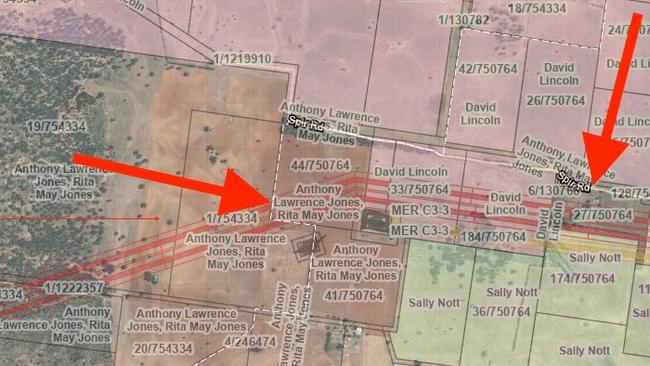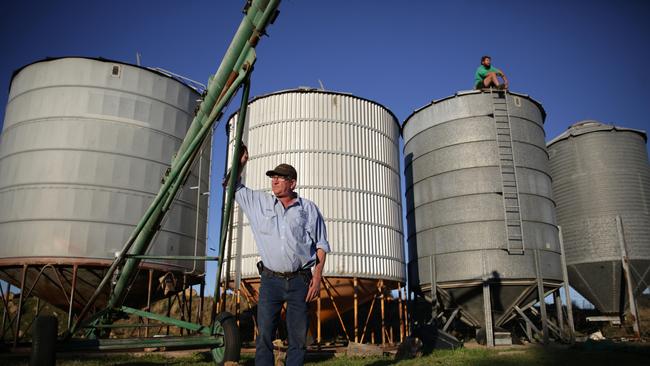Farmers call for more negotiation with NSW government over land acquisition
Farmers are accusing the NSW government of using “bullying tactics” in forcibly acquiring their land for transmission lines as part of renewable energy zones.
NSW
Don't miss out on the headlines from NSW. Followed categories will be added to My News.
Farmers across NSW are accusing the state government of using “bullying tactics” in forcibly acquiring their land for new transmission lines as part of the development of new renewable energy zones (REZ).
Multiple landholders have said they’re facing the prospect of demolishing farming infrastructure, with some farms cut in two by large power lines which can measure 40 metres wide. The Daily Telegraph spoke with nine farmers across the Central-West Orana REZ near Mudgee who felt there had been a lack of communication and very little ability to negotiate as to where the wires will go.
Anthony Jones and his wife Anne are fighting with state-run EnergyCo to renegotiate the position of transmission lines across his 90-year-old mother’s 28-acre property near Dunedoo.
Rita Jones’ property is so small, her son is worried the lines will swallow it up. The planned lines will go over 50 metres from her house.
Mr Jones said after years of battling devastating storms, mice plagues and Covid, having to battle EnergyCo was the last straw.

The couple who run a 2000 acre farm next door to Mr Jones’ mother, will also get transmission lines through their property.
“We’ve been trying to negotiate a different path,” Anne Jones said.
“EnergyCo has said – we can try and compromise but in the end we can force acquisition of your place.”
“We’re trying to push it south of the house because we acknowledge that for the good of the state we need renewables and transmission lines and it has to be in somebody’s backyard.”
The majority of landholders spoken to were open to the lines being built on their property but felt they had no power to compromise on the location.


Dunedoo farmer Stuart Hackney will have transmission lines go right down the centre of his 660 acre farm. He has tried to change the location to go to the side of the property. As there are 4.3 metre height restrictions as to what farm machinery can be used under the wires, Mr Hackney said the current location will decimate his ability to produce crops on his farm.
Additionally he has been told he may need to pull down grain silos, cattle yards and a work shed that are built in the path of the wires.
While all landholders will be paid $200,000 per kilometre over 20 years, Mr Hackney said the money is not enough to cover the loss of land use.
“The government has set a stupid time frame on it to get this up and running and there is no diligence shown to the owners of the property,” he said.
“They’re just walking all over us, we’re treated like dogs, their bullying tactics are just unreal.”

With the shutdown of Eraring power station due in 2025, the government is racing to get much of the REZs completed by 2027.
An EnergyCo spokesperson said they were committed to working with landholders to resolve property acquisition.
“This includes investigating opportunities to suit landowner preferences on where transmission lines are located through their property,” the spokesperson said.
“This will be considered against planning, environmental, design and constructability constraints.”
EnergyCo said they have a “strong preference to complete acquisition by mutual agreement” within a six-month period, after which the department will commence a compulsory acquisition process.
NSW Farmers policy director Nick Savage criticised the lack of consultation with landholders.
“EnergyCo is tasked with meaningful engagement with communities, but the rising groundswell of opposition to transmission lines and the cumulative impact in some areas of renewable energy generation is a demonstration that this is not working,” he said.
“While it may be convenient for the government to say it needs to get this done with haste, in regional NSW the cheap and reliable power for urban areas is coming at a real cost.”

In an attempt to placate angry landholders Energy Minister Penny Sharpe launched an inquiry last month into the feasibility of underground transmission lines, despite previous reviews finding underground lines were worse for the environment.
A previous review commissioned by Transgrid in 2021 found the estimation of undergrounding the 360 km HumeLink transmission lines would cost an extra $8.2 billion. The price of the project is currently $3.3 billion and would have blown out to $11.5 billion should they be put under the ground.
Additionally the review found in cases where high voltage cables go underground, to prevent overheating thermal soil needs to go on top. As very few plants can grow in thermal soil, the report found the effects on food production was even greater, as many of these cables were over 40 metres wide.

Executive general manager of Network at Transgrid, Marie Jordan said underground wires would undoubtedly increase energy bills for consumers and the environmental impacts would be greater.
“Environmentally there’s a lot more of a footprint of an underground wire than overhead.
It looks like a mining site. It looks like a mining site when they start,” she said.
Additionally the report found maintenance of the lines to be vastly more expensive, with breaks harder to locate.
Wagga Wagga MP Joe McGirr has been pushing for a review into the plausibility of underground wires for years. He believes estimations of cost blowing out by 10 times to be an overstatement.
“Let’s say it’s three times the cost but it is significantly better for carriage of electricity, fire risk, environmental degradation and it looks better,” he said.


